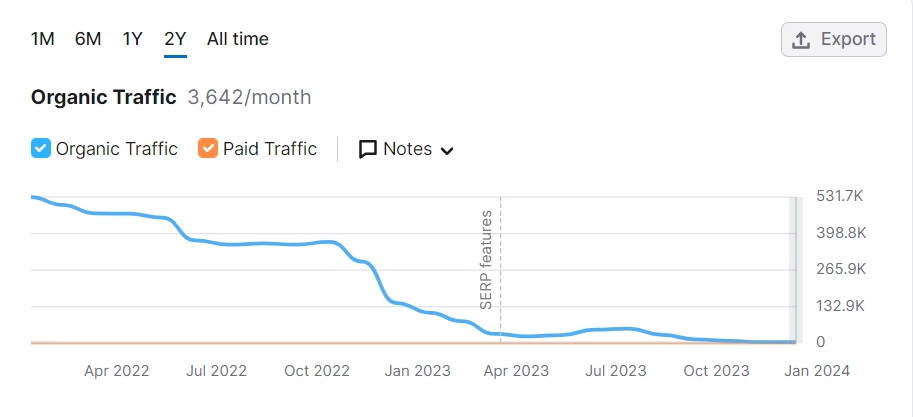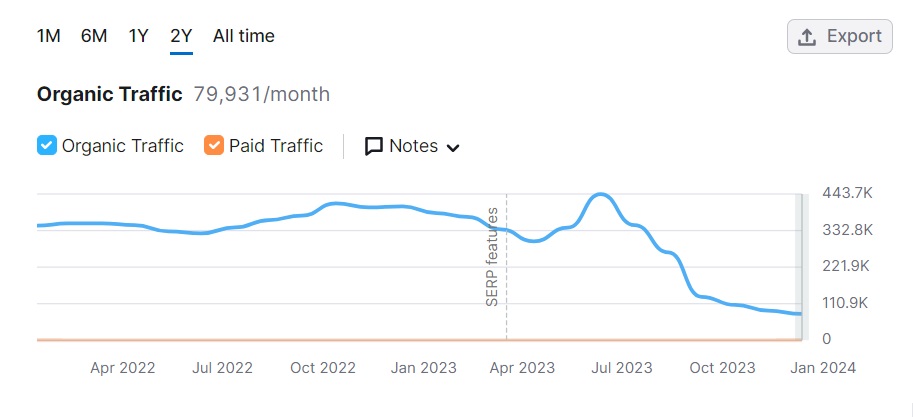TLDR: I turned off all advertisements on my flagship website, in an experiment to regain lost rankings. Continue reading to see why I did this and how I calculated this 39% improvement in helpfulness.
With all the algorithm updates in Q4 of 2023, there have been huge movements in organic traffic. Google’s Helpful Content Update has been one of the most impactful updates, and my flagship website – Tracking Happiness – has been hit hard: A 50% drop in traffic.
But it could have been a lot worse. A lot of similar websites – friends and competitors – have seen more drastic impacts. Some website owners have seen all their traffic evaporate overnight. I have seen dozens and dozens of traffic charts like these:


Images like these make me a little less worried about my 50% drop in traffic. However, it still hurts.
But instead of embracing a victim mindset, I want to face reality and take responsibility:
Can I make my content better?
Is the content I’m publishing on my brands as helpful as it can be? Does it satisfy the needs of someone coming from Google?
I think it does, as proven by lots of positive personal emails and comments.
But there’s one thing that has a huge negative impact on my content’s helpfulness.
It’s ads.
Enter Mediavine
Tracking Happiness contains over 600 original articles and they are all accessible for free. But, in order to keep the lights on, I decided to put advertisements in the content.
These advertisements are dynamically inserted in my content thanks to Mediavine: an advertisement platform that makes sure my readers see relevant ads. To be fair, I consider Mediavine to be a great company. They’ve been nothing but helpful for me, and even though some people have complained about their ads, I was always happy once my monthly cheque rolled into my account.
For years, these ads allowed me to run a profitable business and reinvest these profits back into more original content.
But I’ve always been a little embarrassed by the ads.
They. Are. Everywhere.
There’s a sticky leaderboard ad at the bottom of the page. There’s a sticky ad in the sidebar. There’s a video ad that starts playing in the bottom of your screen as soon as you scroll down far enough. And then there’s the “in-content” ads.
As a result, it’s practically impossible to not be affected by this constant exposure of advertisements.

It’s annoying, it doesn’t provide any value, it diverts attention from the actual content, and it adds a lot of bandwidth to the website.
Long story short: these ads make my content a lot less helpful.
How have Mediavine websites performed after the Helpful Content Update?
I’m not the only publisher that makes use of Mediavine’s ad platform. In fact, over 10,000 other websites are monetized with the same distracting ads.
A lot of these small publishers were hit so hard, that they started making some noise. They began talking about their traffic declines. They started posting screenshots of their Google Analytics data. It seemed like everybody in this publishing place saw their traffic evaporate overnight. Some publishers shared stories of 90% traffic drops, which basically means that their livelihoods were suddenly gone.
Mediavine noticed this uproar and published their own insights. They’re claiming that 5.8% of the websites in their ecosystem have seen negative impacts (607 out of 10,302 websites).
However, they also claim that 11,3% actually saw a positive increase (1,170 out of 10,302 websites).
I call BS
Here’s the thing: I’m 90% sure that this data is not completely honest. I’m quite active in Mediavine’s Facebook group and the things I’m hearing and seeing in there tell a different story.
I’m also quite vigilant in observing other websites’ traffic trends, and nearly every website I check has seen a massive drop in traffic. While Mediavine doesn’t publish a list of all their 11,302 publishers, there are actually some ways to get that information. And I’ve checked about 100 websites (at random) and this confirms to me that websites that run Mediavine ads are impacted much more.
I’m not in the habit of doxxing other people’s sites, so I won’t actually be backing up my – admittedly – anecdotal observations. I’m just saying what I’m seeing online, and showing what I’m doing to make my website(s) more helpful to readers.
So, more ads = algorithmic traffic declines?
Not really.
There are plenty of websites that are plastered with obnoxious ads, but are thriving and seeing gains upon gains upon gains.
Forbes, Reader’s Digest, The Daily Mail, WebMD, etc.
These are sites that are all heavily filled with advertisements. But, unfortunately, I’m here to tell you that these websites are playing by a different set of rules.
What all these websites have in common is that they’re managed by massive media behemoths. They have backlink profiles bigger than what most small publishers can even comprehend. They have direct traffic. Their brand name receives a ton of search traffic.
Also, they have massive teams of professionals and lots of resources and money to publish content at scale.
And so, because Google’s algorithms are still mostly dependent on these kind of trust signals (read: backlinks), they generally have a better shot at reaching the first page of the search results.
Even though their content of played with just as many ads as mine (or even more).
Determining the helpfulness of my content
Google has written a lot about what they consider to be helpful content here.
But this sentence covers it all:
The helpful content system aims to better reward content where visitors feel they’ve had a satisfying experience, while content that doesn’t meet a visitor’s expectations won’t perform as well.
Google Search Central
So how can Google measure a website’s helpfulness? I believe it is mostly reliant on user interactions. Some ways Google measures this are:
- If people find your page but then press “back” and go look for a better page, that’s considered a bad thing (it’s called pogo-sticking).
- If users stick around long enough to find what they’re looking for, they’ll score high on the Information Satisfaction (IS) charts. If you want to know what this means, here’s a great writeup of recently revealed information from Google’s anti-trust case by AJ Kohn from Blind Five Year Old.
If users visit your website and then promptly get a shitload of ads thrown at their face, they are more likely to hit that “back” button.
And it’s this common sense that led me to think: How much are these ads impacting my content’s helpfulness?
Helpfulness scores
Think of – arguably – the most helpful website on the internet: Wikipedia.
Their content is 100% helpful. There are no:
- Ads.
- Annoying calls to actions.
- Pop-ups.
- Stock photos.
In fact, the content on Wikipedia is carefully reviewed by a hugely dedicated group of volunteers. Even the smallest edit gets scrutinized as if you were trying to change a federal law.
If a “Helpfulness score” does exist, I believe Wikipedia would score a perfect 100%.
Now, when I look at my own website, I see a lot of dynamically inserted ads in my content. I consider the ads to be 0% helpful.
So with that in mind, I’ve calculated my content’s helpfulness factor. It’s basical calculated as follows:
(All content - Unhelpful content) / All contentI created this simple spreadsheet and determined that my article was 65.99% helpful.
Note: the image in that spreadsheet is blurry because Google Sheets couldn’t handle the full screenshot in high resolution. This is the page that I used to calculate this score.
The things that impacted my score here:
- A stock photo in the header.
- A shitload of semi-sticky in-content ads.
- My email opt-in forms.
By far the biggest impact comes from the in-content ads.
In fact, if I decided to remove these ads, my helpfulness score would increase to 91.94%. That’s a 39% increase!
I turned off Mediavine ads
So, even though Mediavine’s ads provide me with a nice monthly paycheck, I turned off their ads. Completely.
I’m going to wait 2 weeks to see if this impacts anything. I will keep an eye on my Google rankings and the site’s user engagement signals (time on page, session duration, bounce rate, etc).
I feel comfortable doing this because I’m not dependent on the site’s income. Also, Q1 is often a slow month for ad income anyway, as advertisers are regrouping after the busy holiday season.
Wrapping up
I’m well aware this experiment is flawed, no matter what the outcome of this action is going to be. But since not a lot of publishers look at the helpfulness of their own content, I wanted to publish my thoughts here. Advertisements are always going to be important to provide websites with predictable income, but at some point, it’s going to hurt the user experience.
My hypothesis is that Google has deemed my website as too ad-heavy, and thus I’ve been penalized (like hundreds or thousands of other Mediavine publishers). I’ll be back with an update after I see what happens!
What do you think? Has this given you some food for thought? Let me know in the comments below!
